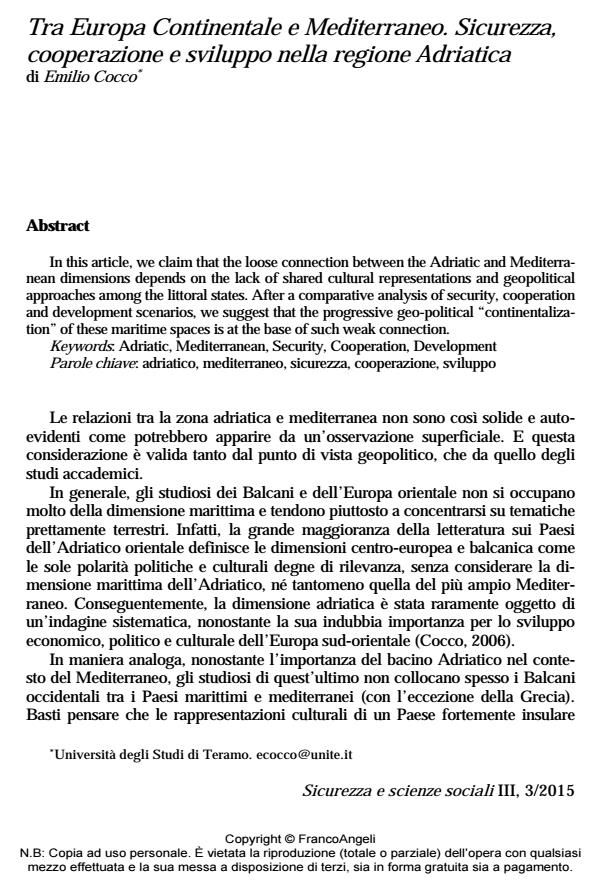Tra Europa Continentale e Mediterraneo. Sicurezza, cooperazione e sviluppo nella regione Adriatica
Titolo Rivista SICUREZZA E SCIENZE SOCIALI
Autori/Curatori Emilio Cocco
Anno di pubblicazione 2016 Fascicolo 2015/3 Lingua Italiano
Numero pagine 15 P. 33-47 Dimensione file 109 KB
DOI 10.3280/SISS2015-003004
Il DOI è il codice a barre della proprietà intellettuale: per saperne di più
clicca qui
Qui sotto puoi vedere in anteprima la prima pagina di questo articolo.
Se questo articolo ti interessa, lo puoi acquistare (e scaricare in formato pdf) seguendo le facili indicazioni per acquistare il download credit. Acquista Download Credits per scaricare questo Articolo in formato PDF

FrancoAngeli è membro della Publishers International Linking Association, Inc (PILA)associazione indipendente e non profit per facilitare (attraverso i servizi tecnologici implementati da CrossRef.org) l’accesso degli studiosi ai contenuti digitali nelle pubblicazioni professionali e scientifiche
In this article, we claim that the loose connection between the Adriatic and Mediterranean dimensions depends on the lack of shared cultural representations and geopolitical approaches among the littoral states. After a comparative analysis of security, cooperation and development scenarios, we suggest that the progressive geo-political "continentalization" of these maritime spaces is at the base of such weak connection.;
Keywords:Adriatico, mediterraneo, sicurezza, cooperazione, sviluppo
- Albertini M. (2011). The Adriatic Connection: Mafia Links from Italy to the Western Balkans. Balkananalysis, testo disponibile al sito: http://www.balkanalysis.com/serbia/2011/06/01/the-adriatic-connection-mafia-links-from-italy-to-the-western-balkans.
- Ballinger P. (2003). History in Exile. Memory and Identity at the Borders of the Balkans. Princeton: Princeton University Press.
- Ballinger P. (2006). Lines in the Water, Peoples on the Map. Maritime Museums and the Representations of Cultural Boundaries in the Upper Adriatic. Narodna umjetnost: Croatian Journal of Ethnology and Folklore Research, 43, 1: 15-41.
- Ballinger P. (2007). La frantumazione dello spazio adriatico. In Cocco E., Minardi E., a cura di, Immaginare l’Adriatico. Milano: FrancoAngeli.
- Baskar B. (2010). The Most Beautiful Part of Italy. Memories of Fascist Empire-building in the Adriatic. In: Bechev D., Nicolaidis K., a cura di, Mediterranean Frontiers. Borders, Conflict and Memory in transnational World. London Tauris Academic Studies, Library of International Relations.
- Bianchini S., Woodward S.L. (2003). From the Adriatic to the Caucasus. Viable Dynamics of Stabilization. Ravenna: Longo.
- Bilardo U., Mureddu G. (2005). Traffico petroliero e sostenibilità ambientale. Roma: Unione Petrolifera.
- Braudel F. (1972). The Mediterranean and the Mediterranean World in the Age of Phillip II. Volume I. New York: Harper Perennial.
- Bufon M., Gosar A. (2007). New Borders in a New Europe: eliminating and making borders in Central Europe. In: Armstrong W., Anderson J., a cura di, Geopolitics of the European Union Enlargement. The Fortress empire. London: Routledge.
- Bufon M., Markelj V. (2010). Regional Policies and Cross-border cooperation: new challenges and new development models in Central Europe. Revista Romănâ de Geografie Politică, XII, 1: 18-28.
- Cattaruzza M. (2003). Nazionalismi di frontiera. Identità contrapposte sull’Adriatico nord-orientale: 1850-1950. Soveria-Manelli: Rubettino.
- Cocco E. (2006). Introduction: The Adriatic Space of Identity. Narodna umjetnost: Croatian Journal of Ethnology and Folklore Research, 43, 1: 7-14.
- Cugusi B. (2013). Macro-regional dynamics in the Mediterranean area(s): The case of the Adriatic-Ionian Macro-region. Euborderegion, 6/1, testo disponibile al sito: http://www.euborderregions.eu/.
- Del Bianco D. (2005). Creating the Goriska-Gorizia Euroregion: a European cross-border Administrative Model for Integrated Socio-Economic Development in the Upper Adriatic, Institut Universitari d’Estudis Europeus.
- Del Bianco D., a cura di (2008). Protecting the Adriatic Seaways, critical infrastructures protection project report. Gorizia: ISIG-EU.
- Horden P., Purcell N. (2010). The Corrupting Sea. A study of Mediterranean History. Oxford: Blackwell.
- Graziani T. (2010). Geopolitics of Republican Italy. EURASIA: Rivista di studi geopolitici, testo disponibile al sito: http://www.eurasia-rivista.org/geopolitics-of-republican-italy/6769/.
- Jenček P., Twrdy E., Klodić M., Zanne M., Jerger T., Sklaska J. (2008). Adriatic-Baltic landbridge: development of institutional setting-pilot projects: pilot projectsfinding and transferability issues. A-B Landbrige Consortium.
- Johler R. (1999). A Local Construction – or: What Have the Alps to do with a Global Reading of the Mediterranean. Narodna umjetnost: Croatian Journal of Ethnology and Folklore Research, 36 (1): 87-102.
- Lita L. (2010). I “nostri” Balcani. Fondazione Magna Carta, testo disponibile al sito: http://www.magna-carta.it/content/nostri-balcani.
- Magaš D. (1997). The development of Geographical and Geopolitical Position of Croatia. Geoadria, 2: 5-36.
- Morović M., Ivanov A. (2011). Oil Spill Monitoring in the Croatian Waters: needs and possibilities. Acta Adriatica, 52 (1).
- Profazio U. (2011). Trans Adriatic pipeline: Economic Advantages over the Competitors but Equal Political Risks. Portal on Central and Eastern Europe – Businnes Reports.
- Ralchev S. (2012). Energy in the Western Balkans: A Strategic Overview. Institute for Regional and International Studies: Strategic Papers Collection.
- Reill D.K., Klabjan B., Tchoukarine I., Wolff L., Ballinger P. (2011). Forum. A Contested Adriatic. Austrian History Yearbook, 42: 3-63.
- Solioz C., Stubbs P. (2009). Emergent regional cooperation in South-East Europe: towards “open regionalism?”. Southeast European and Black Sea Studies, 9, 1-2: 1-16. DOI: 10.1080/1468385090272335
- Strazzari F., Coticchia F. (2012). The Phantom Menace: Transnational Organised Crime. Towards Open Regionalism in South East Europe. Busto Arsizio (VA): Nomos.
- Trinchese S., Caccamo F. (2008). Adriatico contemporaneo. Rotte e percezioni del mare comune tra Ottocento e Novecento. Milano: FrancoAngeli.
- Valenza A. (2013). Options for an Adriatic-Ionian Macro-Region, testo disponibile al sito: http://www.t33.it/en/node/294
- Vecchiato D. (2010). The Adriatic Euro-region, Strategic Institution Building. Pace Diritti Umani, 3: 53-61, testo disponibile al sito: http://www.adriaticeuroregion.info/.
- Vidas D. (2010). The Adriatic Sea Today: Unsolved Issues and Challenges. Mepielan Center e-bulletin, disponibile al sito: http://www.mepielan-ebulletin.gr/
- Wörsdörfer R. (2004). Krisenherd Adria 1915-1955: Konstruktion und Artikulation des Nationalen im italienisch-jugoslawischen Grenzraum. Paderborn: Ferdinand Schöningh
Emilio Cocco, Tra Europa Continentale e Mediterraneo. Sicurezza, cooperazione e sviluppo nella regione Adriatica in "SICUREZZA E SCIENZE SOCIALI" 3/2015, pp 33-47, DOI: 10.3280/SISS2015-003004